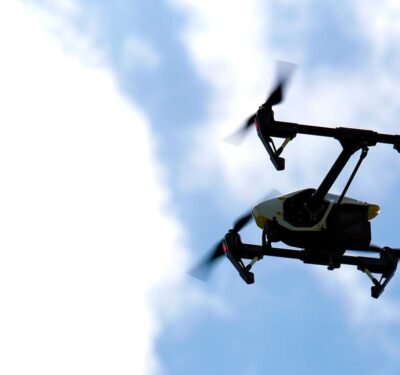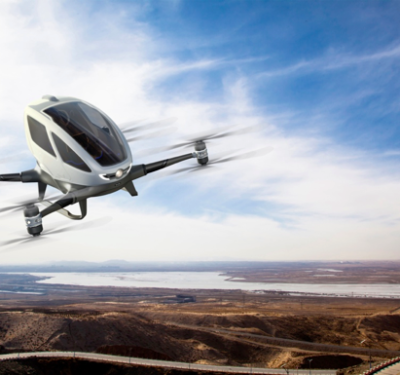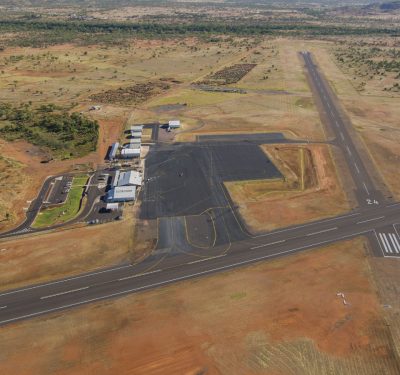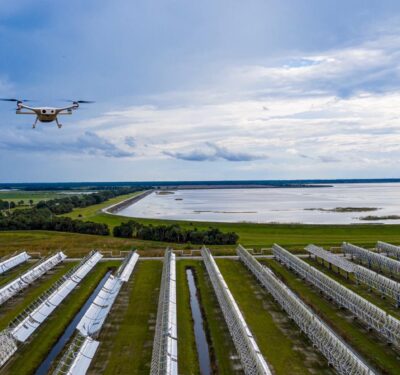Heavy lift drones are transforming military logistics by transporting supplies in contested environments while reducing risk to personnel. With the ability to carry up to 500 pounds or more, these drones are fast, versatile and increasingly indispensable in modern warfare.

There are times when bigger is just better.
Let’s say you’re part of a small unit operating in a contested environment and you urgently need food, medicine and ammunition. A heavy lift drone can transport what you need to a point where you can retrieve it. Added to your woes are the fact you’re in challenging terrain and intermittently under fire. Again, the heavy lift drone comes to the rescue, minimizing risk to supply personnel.
Heavy lift drones are becoming more and more important for military applications. Able to transport 60 to 500 pounds or more, they are faster and more economical than most other methods, can sometimes fly autonomously and they don’t risk people’s lives. The larger models can even evacuate the injured.
While logistics (supply) are the most common use, they can also carry heavy sensor packages that can detect explosives, deliver equipment and perform ISR. They often employ carbon fiber components and frames which are both light weight and strong, as well as powerful motors and counter-rotating propeller systems for maximum lift.

TRUAS
In August 2022 the Marine Corps contracted with Belcamp, Maryland SURVICE Engineering Company for 35 Tactical Resupply Unmanned Aircraft System (TRUAS) drones, followed by an order for 30 additional drones in March 2023. In April 2023 SURVICE received a $8.3 million order from the U.S. Department of Defense for 21 TRV-150C TRUAS drones. The drones ae made by Reading, U.K. based Malloy Aeronautics and sold by SURVICE Engineering in the U.S.
Early last year, Marine Corps leaders at the Installations and Logistics Board event in Quantico, Virgina, observed the TRUAS drones carry a payload over a short distance, drop it at a specified location and return to the starting point. Master Sargeant Chris Genualdi, quoted on a Marine Corps website, said the concept of TRUAS may seem simple but can have a significant impact on combat supply transportation. The TRUAS is highly automated and uses programmed coordinates to direct the flight. It can carry up to 150 pounds of payload such as medical supplies, food, batteries and ammunition over a 9-mile radius. Genualdi said a Marine with no experience with unmanned aircraft systems can be trained to operate and conduct field maintenance in just five days.
“The TRUAS revolutionizes our resupply capabilities in austere, contested environments and lightens tactical loads to improve survivability and maneuverability,” 1st Lt. Robert R. Lebron, the platoon commander of Combat Logistics Platoon 1, CLB-15 said, according to a Marine website. “It represents UAS technology that will provide an autonomous, organic logistics capability for distribution of up to 150 pounds of critical supplies for squad-size elements. It’s highly automated and has pinpoint accuracy that enables U.S. to sustain operations in areas previously inaccessible to traditional resupply methods, enhancing our agility and operational tempo.”
Late last year, the first six production TRUAS systems arrived at the Marines Third Littoral Logistics Battalion (LLB-3) in Kaneohe Bay in Hawaii and Combat Logistics Battalion 15, 15th Marine Expeditionary Unit employed the system during exercises in the Philippines in April and May.
There are several significant players in the heavy lift space. Here is a sampling:

DRAGANFLY
Saskatoon, Saskatchewan based Draganfly makes a new heavy lift drone that can carry up to 67 pounds with a 55-minute flight time. It has a heavy lift winch system and a 15 x 17 x 34-inch heavy lift delivery box and options for various cameras and sensing systems.
They also make the Commander 3 XL which can carry up to 26 lbs., dates from around 2021, and was used mostly for search and rescue.
“We’ve had a tendency to make drones that are a little bit larger and a little bit more sophisticated in the last 10 or 12 years, as opposed to the small drones, and that’s what led us to making bigger and bigger drones,” CEO Cameron Chell said. “Some of our initial military customers were looking for the capability to run dual payloads, such as two different cameras, or say, a targeting camera, and then also a drop-down winch; so, we developed the Commander 3 XL, which can carry about 22 pounds of payload and could run dual payloads at the same time,” Chell said.
“But then the military began looking to develop ways to transport medical equipment, first aid, water and blankets, those type of things and we are now seeing more applications for critical resupply by autonomous drones. They might want to set up lights for a landing area or going in to drop equipment for an advanced forward operating base, things like that. So, we’re moving from our Commander 3 XL to the heavy lift; and we’ve just recently been commissioned to develop a super heavy lift which will carry a 220.5 pound payload. That will go out for its first pilot project in November.”
Chell noted these drones range from about $50,000 to $250,000 and “even though they’re definitely resupplying forward operating folks, they’re not considered disposable.” He said the most common payloads are fuel resupply, medical and communication equipment, and ammunition; as well as food and water.
He also said the costliest components on these drones are the electronic warfare components, such as variable frequency radios and shielding antennas that prevent jamming.
Chell said military drones usually have a sophisticated payload box with electronics ad perhaps an extra battery to extend the flight time of the drone. He added that some type of refrigeration of a thermal component is also common for medical contents such as insulin.
“Another thing that’s quite typical,” he said, is a downward facing camera, “so if the drone isn’t landing and is using a winch, it can do a precision drop.”
Chell said the drones have autonomous capability, but they’re not relying on it at this point. Although operators have their eyes on the drone the whole time, they may not be in control the whole time. When they do fly on their own, they typically employ GPS.
Resupply is also a big topic right now, Chell said. “For example, if you have a party inland and you need to resupply them from a ship.”
“The idea of using drones for resupply and strategic initiatives is increasing exponentially across the military because they’re such an effective force multiplier, and from a cost perspective, they are exponentially less expensive to operate than manned aircraft,” Chell said.

MALLOY AERONAUTICS
Reading, U.K. based Malloy Aeronautics, which was recently acquired by BAE Systems U.K., makes several models of very heavy lift drones. The T150 can carry about 150 pounds, the T400 can carry 400 pounds, while the T6 can lift 600 pounds. They are operational in inclement weather and have removable batteries to avoid recharging time.
“Our main focus is the T150,” said Ben Long, business development officer. The range is from 6.2 miles, depending on payload for the T150, and a little bit more for the larger platforms. The drones are automated, meaning they will follow a program. They are not yet fully autonomous, although that is in the future, Long said.
As to equipment, it depends on what the customer wants, but usual equipment includes a radio or mesh net radio and a thermal camera, he said.
“We have different ways to drop things,” Long said. “It could land, keep its propeller spinning, release the payload and fly off. The drones might use LiDAR or radar, so you could tell it to stop five meters above the ground and release the payload. You could also mimic helicopters and use a long line delivery. The U.S. Marines use parachute drops as well.”
He said a person does not necessarily need to be at the drop point as the drones can be equipped with radios, satcoms and other technologies. “You could put something in before the troops get there and they come after it,” he said.
Long also said the company has been working with the U.S. Department of Defense (DOD) for about 10 years, and has programs with the U.S. Army, as well as the U.K. Ministry of Defense. They partner with Maryland based SURVICE Engineering Company who sells their drones in the U.S. and manufactures the TRUAS drone for the American military.
“What’s special about us, is that right from the get-go, we’ve been focused on heavy lift logistics,” Long explained. “It’s a tougher technology to handle, and, when things go wrong it can be a bit more expensive. So, during the development cycle, it’s harder, and as a result, there are not a lot of people operating in this area. We have first mover’s advantage.”

HARRIS AERIAL
Casselberry, Florida based Harris Aerial makes the Carrier H6 EFI Hybrid, which has three power formats that convert in minutes between EFI (electronic fuel injection), hydrogen electric or fully electric. The system can fly for up to 2.5 hours with an 11 pound payload. They also make the Carrier Hx8 and Hx8 Tether, co-axial octocopters with a 17.6 pound capacity; and the Carrier H6HL with an 88 pound capacity. The drones can be flown manually or autonomously using GNSS.
Eric Agnello, vice president of sales and business development, said the most common military uses of their drones include cargo drop, medical and food supplies, equipment and munitions. Their most popular drone is the Carrier H6HL with its larger payload capacity. Currently, there is “lots of testing going on with the military and the H6HL.”
As the heavy lift space continues to grow, one thing seems certain: fewer military personnel will be in harm’s way as things need to be moved.







